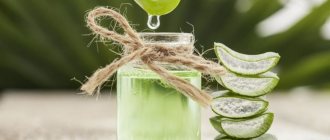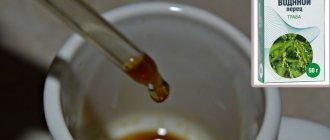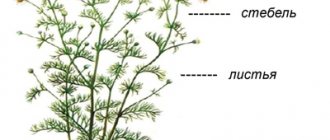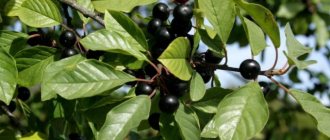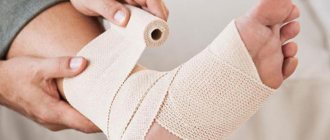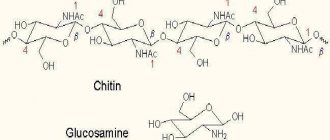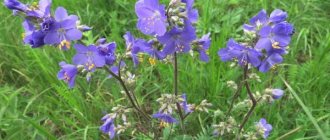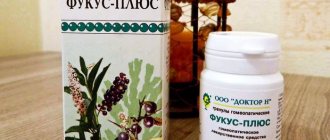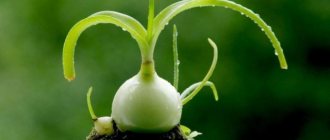The Latin name of one of the varieties of elecampane is Inula Helenium. They say that the plant got its name in honor of Helen of Troy. The ancient Greeks believed that the fiery yellow flowers of elecampane appeared in the places where Helen's tears fell when Paris kidnapped her from Sparta. This plant was also called Elenina grass in Rus'. Although there were other names - oman, divosil, wild sunflower, somnit.
Our ancestors considered this herb to be the source of “nine powers”. It is known that Russian warriors, when going on a campaign, always took with them crushed elecampane root, which served them as a talisman and protection from the enemy and evil forces. And women believed in another magical ability of Elena’s herb - love spell.
Elecampane P: indispensable in the fight against inflammation. Plus nine powers for your health
Elecampane P is a natural anti-inflammatory drug based on elecampane with the addition of vitamin C, which enhances the effect. Elecampane P has all the properties of the elecampane plant, since cryogenic treatment of the plant is used for tableting. It allows you to keep all its active ingredients unchanged. Antibacterial, expectorant, antispasmodic, regenerating, analgesic and other beneficial properties of elecampane make it effective for the prevention of a number of diseases. Thanks to a specific set of biologically active substances, Elecampane P promotes the safe correction of disorders in the digestive, respiratory, genitourinary and other systems . The drug also improves metabolic processes, and primarily the metabolism of fats and carbohydrates .
How to properly prepare and store elecampane?
It is recommended to collect the medicinal plant from spring to autumn. It is better to collect the root in the middle or end of September, then it will be most beneficial for the body. By autumn, the root has absorbed all the useful substances, is ripe and ready for harvest.
The above-ground part is collected in mid-summer, when the flowers are actively blooming and bees pollinate the inflorescences. Spring, preferably March-April, is also suitable for collecting the top part of elecampane.
Collecting the rhizome is quite simple; you should dig it up and separate the rotten parts from the healthy root. The upper part should be cut off with a sharp tool at a height of 20 cm from the ground. Carefully ensure that rotten or damaged flowers do not get into healthy ones.
Before drying the rhizome, it must be cut into thin slices of 10 cm. Drying should be carried out at a temperature of no more than 40 °C. The upper part is dried at a temperature of 50 °C.
The collection should be stored in a fabric bag in a dark place, away from moisture and sunlight.
The medicinal properties of elecampane exceed all common herbs. The root will cure colds and boost immunity. The body will become stronger and more resistant to diseases. It’s great if natural medicines in the form of various herbal preparations come to the aid of the body.
Article design: Mila Friedan
Fighting inflammation must include addressing the cause!
Inflammation accompanies most diseases. But it is not an absolute evil, but a protective-adaptive reaction. The goal of any inflammatory process is to get rid of damaged tissue elements and the provocateurs of pathology themselves. Such clearing of the territory is the most important condition for restoring damaged areas.
Therefore, suppressing any inflammation with anti-inflammatory drugs (NSAIDs) without eliminating the cause of the disease is a risky business. The anti-inflammatory effect of Elecampane P is fundamentally different. With a minimum of side effects (possible only in the case of an allergy to the plant or an overdose), Elecampane P helps relieve inflammation without mechanically blocking its mechanisms, but by eliminating its very causes.
In the case of respiratory tract diseases, it helps to destroy pathogenic microorganisms - the causative agents of the disease, and if there is a cough, it also liquefies and removes mucus from the bronchi and lungs. In case of inflammation in the gastrointestinal tract, it also helps to destroy pathogenic viruses and bacteria and improve the intestinal microflora. And if the gallbladder or bladder is inflamed, Elecampane P helps eliminate stagnation of bile or urine. Let's take a closer look at how and due to what substances in its composition Elecampane P works for various diseases.
Elecampane herbal tea
The root and rhizomes of elecampane are used in the form of tea or extract for diseases of the respiratory organs and stomach. According to Bulgarian researchers, elecampane has a beneficial effect on liver diseases, hemorrhoids, and externally on itchy skin with skin rashes and gum inflammation.
Recipe for herbal tea from elecampane rhizome:
Pour 1 teaspoon of raw material into 1/4 liter of boiling water and let it brew for 15 minutes. For coughs and asthma, this tea is sweetened with honey and drunk in small sips. Dosage: 2-4 times a day, 1 cup.
| Cough tea mixture recipe: | |
| Rhizome of elecampane | 20.0 gr. |
| thyme herb | 15.0 gr. |
| Primrose root | 5.0 gr. |
Pour one teaspoon of the mixture into 1/4 liter of cold water, slowly heat to a boil, let it simmer for about half a minute, strain and drink, sweetened with honey (diabetics can sweeten with stevia), in small sips 2-4 times a day, 1 cup each.
What substances does Elecampane P work from?
The pharmacological activity of the plant is determined by the presence in it of up to 3% essential oil , called “alantine” [1, p. 244]. It is based on alanthol, helenin, proazulene , the sum of several dozen bitter compounds - sesquiterpene lactones . Bitterness is primarily responsible for the anti-inflammatory, bactericidal, antiviral, fungicidal (antifungal), detoxifying, choleretic and other properties of the plant. The stimulating effect of bitterness on the digestive processes is difficult to downplay.
No less important for human health is another component of the plant - the polysaccharide inulin , the content of which in the roots of elecampane reaches 40% of the total mass [1, p. 244]. It was from him that this herb received its Latin name - Inula. Being a prebiotic, it serves as a nutrient substrate for human-friendly intestinal microflora. It also helps lower blood sugar levels and cleanse the body of toxins, waste, radionuclides, as well as excess low-density cholesterol.
In addition, the following were found in the roots of elecampane:
- saponins , which have moderate diuretic, sedative, antiulcer, antisclerotic properties and the ability to reduce the level of “bad” cholesterol;
- flavonoids (quercetin, isoquercetin), known for their antioxidant, anti-inflammatory, neuroprotective, anti-edema and anti-cancer properties;
- resins that have a bactericidal and bacteriostatic, laxative effect on the body;
- gums, mucous substances that help eliminate toxins, reduce bad cholesterol levels, improve the absorption of nutrients by the intestinal walls;
- alkaloids , in which pharmacologist K.L. Zelenskaya and co-authors during experiments revealed pronounced analgesic effects [2].
- organic acids (acetic and benzoic), which alkalize the body and maintain an optimal balance of the acid-base environment, which prevents the development of harmful microflora, fermentation and putrefaction processes in the intestines.
Elecampane roots are rich in vitamins C and E - the strongest antioxidants. Moreover, their maximum antioxidant activity is possible only when combined with each other, as many researchers on this issue point out [3; 4].
Vitamin C has pronounced gastroprotective, immunostimulating and anti-inflammatory qualities. It is also a synergist for a number of elecampane compounds, enhancing their effect. This was the reason for its additional addition to the composition of Elecampane P.
Characteristics of elecampane
Elecampane looks quite simple, but bright and optimistic. Its flowers resemble daisies with yellow petals.
This plant surprises with its intraspecific diversity. Moreover, all its variants have medicinal properties.
However, in our area you can most often find tall elecampane - an erect plant that grows up to 2 meters in height and blooms with golden baskets. Hence another popular nickname for elecampane - wild sunflower. These plants are not inferior to each other either in growth or in the spectacular flowering.
Elecampane loves moist soil, so it often grows in flooded meadows and along the banks of reservoirs, although sometimes it can be seen on the forest edge and among bushes. The perennial is immediately recognizable by its tall, erect stems, branching closer to the top, and large yellow basket-shaped inflorescences. The flowers are solitary and reach 7 cm in diameter. Very reminiscent of small needle-shaped asters. The leaves of tall elecampane are oblong-ovate, unequally toothed, large, covered with felt underneath.
The rhizome of 2-3 year old plants is used for medicinal purposes. In elecampane it is short and fleshy, has a brown wrinkled surface and yellowish flesh. It has a unique aroma and bitter-spicy taste.
Its British counterpart gets along with the tall elecampane. Although externally similar, they differ in height and size of foliage. The British elecampane is a medium-sized biennial. It has healing properties as a herb that smells like garlic due to its high content of essential oils.
Elecampane P: a remedy for perfect digestion
Elecampane P is indispensable for maintaining and correcting the functioning of the gastrointestinal tract - GIT [1; 5; 6]. Even in the absence of gastroenterological diseases, it is a rare resident of a metropolis who can boast of ideal digestion. The reason for this is an unbalanced, unhealthy diet, which contains too many fast carbohydrates, sweets and too little fiber and vegetable bitterness. But our ancestors consumed turnips, rutabaga, cabbage, onions, radishes and other fruits of the earth in abundance, which protected them from cancer, ulcers, gastritis and a host of other ailments.
Elecampane P is designed to compensate for this imbalance in the diet of modern man. Sesquiterpene lactones of elecampane stimulate the synthesis of digestive enzymes , including pancreatic ones, which is especially important in case of insufficiency of pancreatic function. By increasing the production of gastric juice, sesquiterpene lactones promote the synthesis of buffer substances and the binding of hydrochloric acid .
It is important that when food digestion is activated, the mucous membranes receive protection from aggressive factors such as pathogenic microorganisms, including the bacterium Helicobacter pylori, hydrochloric acid, pepsin and other enzymes. The latter is achieved due to the enveloping effect of inulin and gums. Preserving the integrity of the mucous membranes is the best prevention of gastritis and ulcers . And the neutralization of excess acidity of the internal environment, carried out by organic acids of elecampane, prevents the development of dysbiosis, putrefactive and inflammatory processes in the intestines .
However, elecampane has a reputation as not only a preventive, but also a therapeutic agent. For gastritis and ulcers, it is used to heal ulcerated mucous membranes [1, p. 244]. The acceleration of reparative processes occurs not only due to the above-mentioned enveloping and alkalizing properties of elecampane. The presence of bitterness, antioxidant vitamins C and E, as well as bioflavonoids in Elecampane P helps protect the walls of blood vessels from free radical attacks, strengthen them and grow the capillary network. As a result, blood supply and nutrition of the mucous membranes are improved , which leads to their rapid regeneration.
The ability of elecampane to suppress the activity of pathogenic bacteria, especially Helicobacter pylori [6], which is strongly associated with the occurrence of ulcers and gastritis, also makes its contribution to the fight against ulcers.
In clinical practice, there is successful experience in using elecampane preparations in the acute phase of gastric and duodenal ulcers. On the 10–14th day of their use, improvement in appetite, healing or a significant reduction in size of ulcers are noted [5, p. 145].
With such a common gastrointestinal disaster as dysbiosis, the polysaccharides elecampane inulin and related pseudoinulin and inulenin are indispensable. In transit, bypassing the stomach, they reach the intestines, where they serve as food for valuable microbiota: bifidobacteria and lactobacilli . The effectiveness of the prebiotic inulin against dysbiosis is confirmed by a lot of research by scientists from different countries [7; 8; 9].
Let’s not forget about the anthelmintic properties of elecampane bitters, which are effective in the fight against ascariasis and other helminthic infestations [5, p. 144; 10, p. 233].
Folk recipes with elecampane
Infusion of elecampane
This is the best remedy for treating gastrointestinal diseases such as gastritis, ulcers and pancreatitis, as well as for improving sputum discharge and combating hypertension. Helps cleanse the blood in various skin diseases (furunculosis, acne). Recommended for diarrhea and helminthiasis.
1 tsp dry raw materials, pour 250 ml of chilled boiled water (this is very important), leave for 8 hours and strain. In all cases, take 50 ml 4 times a day 20 minutes before meals.
Rhizome powder
Recommended for hypertension, hepatitis, cholecystitis, colitis, hemorrhoids, gastritis, duodenitis, peptic ulcer. Grind the rhizomes into powder in a coffee grinder and place in a dry jar with a lid for storage. The powder is taken in small quantities, on the tip of a knife (about 1 gram) twice a day before meals.
Elecampane ointment
Helps with various skin diseases that experience delayed healing (eczema, psoriasis), itching, scabies, and joint diseases.
Prepare the dosage form in small quantities and store in the refrigerator. 1 tbsp. Mix root powder with 4–5 tbsp. unsalted chopped lard, cook for 15 minutes and strain through a thick cloth while the ointment is still hot. Lubricate the affected areas once a day until positive changes are visible, then wash these areas with a warm decoction of elecampane root for 5-6 days.
Elecampane decoction
A good stomachic and expectorant. Can be added to a bath to treat skin diseases. 1 tbsp. crushed rhizomes, pour 200 ml of water and boil for 10–15 minutes, then leave for 4 hours, strain. Take warm, 1 tbsp. 3–4 times per day.
Tincture of elecampane with wine
This is an excellent strengthening and tonic for conditions such as an organism weakened by disease and cachexia. 120 gr. fresh rhizomes and roots and pour in 0.5 liters of red wine and cook over low heat for 10 minutes, strain. Take 50 ml two to three times a day. before meals.
Tincture of elecampane with vodka
Recommended for ulcers and gastritis. 250 gr. crushed rhizomes, pour 0.5 liters of vodka, leave for at least 10–14 days, shake periodically, strain. Take 15–20 drops diluted with water 3 times a day for gastritis. For the treatment of ulcerative lesions of the gastrointestinal tract, take 1 tbsp. tinctures in the morning on an empty stomach and wash down with 2-3 tbsp. pork fat.
Tea
A good antitussive. Mix 1 liter of boiling water with 1 tsp. dry rhizomes of the plant, leave for 15 minutes. Take a glass 2-3 times a day, warm, with honey.
Juice
Helps in the treatment of bronchial asthma. Squeeze the juice from fresh rhizomes using a juicer and combine it with honey in a 1:1 ratio. Take 1 tsp. 20 minutes before meals three times a day.
Infusion of fresh rhizomes with vodka against tuberculosis
Mix 500 ml of vodka with 2 cups of fresh rhizomes, grated on a fine grater. Leave for 9 days and place in the refrigerator. Take 1 tbsp. before meals for 2-3 months.
Infusion for the treatment of radiculitis
In a 3-liter jar put a handful of crushed dry elecampane roots, 100 g. yeast and 500-700 gr. honey Top up the volume to the beginning of the neck with boiled, cooled water. Put a rubber glove on top and make several punctures in your fingers. Place this mixture in a warm place, cover the jar with a cloth and leave for 3 weeks. The medicine will ferment - this is normal. After 3 weeks of infusion, pass the mixture through cheesecloth and refrigerate.
Take half a glass in the morning and evening, with honey as a taste.
Freshly picked leaves
They can be applied to wounds, ulcers, areas of erysipelas and scrofulous lesions for 2-3 hours, secured on top with a bandage.
Fresh root
Elecampane root is recommended for coughs and viral infections. Cut the root into small pieces and dissolve them throughout the day (maximum 3 pieces per day).
Liver and Gallbladder Support
The liver is called the chemical laboratory of the human body, responsible for processing foreign toxins and harmful metabolic waste. It also produces a lot of vital substances: glucose, hormones, enzymes, cholesterol, lipids and phospholipids, bile, etc. The liver can also be called a power plant that produces energy for our life, and a storage warehouse for glycogen, vitamins, and blood reserves.
For the proper functioning of the liver and its subsidiary, the gallbladder, plant bitters are also necessary, which Elecampane P. is fully capable of providing. Its sesquiterpene lactones support, stimulate and correct liver functions due to:
- increased bile formation , which improves the movement of food in the intestines, the absorption of fatty acids and vitamins, the utilization of cholesterol and bilirubin;
- activation of contractile movements of the muscles of the gallbladder and biliary tract, which ensures the timely removal of bile from them into the duodenum. Thus, Elecampane P prevents bile stagnation and the inflammatory disease cholecystitis;
- reducing inflammatory processes in the liver (hepatitis) and gall bladder (cholecystitis), which is facilitated by the anti-inflammatory and antimicrobial properties of elecampane [6].
Elecampane polysaccharides, led by inulin, also stimulate the excretion of bile and metabolic processes in the liver, and help strengthen the membranes of hepatocytes (liver cells).
Elecampane P for colds and infectious diseases of the respiratory tract
For colds or respiratory infections, you can use Elecampane P as a herbal antibiotic that does not have the side effects of synthetic drugs. During periods of cold weather and epidemics, when going to crowded places, you can suck elecampane for preventive purposes, which will reduce the risk of infection . And in case of inflammation of the mucous membranes in the mouth and throat, the drug will help their speedy recovery.
Traditionally, elecampane is used to combat influenza, sore throat, tracheitis, bronchitis, pneumonia, asthma, whooping cough . It not only inhibits the growth of pathogenic microorganisms and viruses, but also acts as an expectorant and mucolytic (sputum thinner) . The latter makes it effective for any type of cough, especially in the presence of thick, poorly discharged secretions.
In addition, for colds, flu, and ARVI, the diaphoretic and pain-relieving properties of elecampane will come in handy. And the plant’s ability to neutralize the effects of free radicals, enhanced by vitamin C, will help the body quickly cope with the inflammatory process .
Medicinal properties of root and herb
The product has an expectorant effect, lowers temperature in viral diseases, improves immunity, removes toxins and bile from the body. The root is useful for diabetes, as it is rich in inulin.
Medicinal properties of elecampane root
Side effects may include heartburn and itchy skin. Before using the medicine, you should consult a doctor; individual intolerance is possible.
Sometimes the inflorescence is involved in the creation of perfumes or in compositions for bouquets. For stomach inflammation and bronchial asthma, elecampane root is brewed together with the herb. This way the medicine has a stronger effect on the body and improves the functioning of all digestive organs.
Elecampane P for type II diabetes mellitus
For people diagnosed with type II diabetes or prediabetes, Elecampane P is a real godsend. Firstly, it helps lower blood sugar levels due to the presence of large amounts of inulin. This substance, although similar, is not related to the hormone insulin; however, when taken, the concentration of glucose in the blood drops, and in urine tests, sugar may even completely disappear.
The hypoglycemic mechanism of inulin is associated with its powerful sorption properties. It prevents the intestinal absorption of glucose and its entry into the blood. The effectiveness of inulin in diabetes has been proven in a number of studies [11; 12].
In addition, elecampane generally stimulates the pancreas . In particular, inulin and bitterness of the plant increase the activity of its beta cells, responsible for the synthesis of insulin. As a result, carbohydrate metabolism improves .
Significant for diabetic patients is the property of elecampane to activate fat metabolism , which leads to the utilization of excess cholesterol and the prevention of atherosclerosis and obesity - characteristic companions of diabetes mellitus.
Elecampane P to help the genitourinary system
In herbal medicine, elecampane preparations are widely used for various disorders of the urinary and reproductive systems of both men and women. Thanks to its anti-inflammatory and antibacterial properties, Elecampane P will be useful for infectious and inflammatory diseases of the relevant organs, including in the presence of a chronic focus of infection.
For problems with the kidneys and bladder, it can be used as a diuretic , helping to cleanse these organs of toxic substances and reduce the load on the kidneys.
Women may benefit from elecampane as a means to accelerate the maturation of the egg and increase the chances of conception. It is also used to force the arrival of menstruation when it is delayed in case of hormonal imbalance. However, during pregnancy, a large dose of elecampane can cause uterine bleeding and miscarriage, so it is better to consult a doctor. This plant is also known to relieve painful menstrual symptoms.
In the fight against male infertility, elecampane is used as a means of stimulating the production and motility of sperm.
Contraindications
Contraindications for elecampane are not very extensive, but must be taken into account when prescribing treatment:
- intolerance;
- severe vascular and heart disease;
- severe kidney pathology;
- gastritis with low acidity;
- painful menstruation (for this period);
- hypotension;
- pregnancy;
- chronic atonic constipation.
As for children, treatment is carried out with caution and not earlier than 3 years (according to information from most folk sources). The instructions for use of elecampane rhizomes, which are sold in pharmacies, indicate that the plant is contraindicated for children under 12 years of age.
Author:
Sabuk Tatyana Leonidovna hygienist, epidemiologist
How and to whom else is Elecampane P useful?
It is possible to use elecampane in the following situations or in the presence of the following indications:
- for obesity to stimulate fat metabolism and accelerate fat burning;
- in case of poisoning to detoxify the body and restore the functions of the gastrointestinal tract and liver;
- to facilitate interruption of lactation : approximately a week's course of elecampane is enough for a painless reduction or complete cessation of milk production;
- to increase the absorption of protein , and therefore the growth of muscle mass, which is important for athletes on a protein diet or for people whose body is depleted by illness and requires recovery;
- in case of deficiency of vitamins and minerals , to improve their absorption in the gastrointestinal tract, elecampane significantly increases the absorption of iron, calcium, magnesium, vitamin B9 (folic acid) and other essential nutrients;
- with high cholesterol levels, atherosclerosis as a natural hypocholesterolemic agent;
- for allergies and decreased immunity : by improving the intestinal microflora, Elecampane P also promotes the growth of the body’s defenses as a whole. And the detoxification and sorption properties of the drug make it indispensable in the fight against allergens;
- with increased blood pressure to reduce it: the hypotonic effect of elecampane, although not very pronounced, is physiological and does not carry those “side effects” that potent antihypertensive drugs contain;
- for cancer prevention and cancer control [13].
Elecampane herb - external use
- muscle pain;
- rinsing with a decoction - periodontal disease, gingivitis, stomatitis;
- pain due to rheumatism, arthritis, gynecological diseases - baths, irrigation, lotions, compresses;
- ointment with elecampane - furunculosis, scabies, itchy skin, eczema, lichen, dermatosis;
- fresh leaves placed on wounds accelerate healing, ripening of abscesses, softens tumors;
- elecampane rhizomes replace ginger for the food and canning industries;
- used for making confectionery;
- aromatization of vermouths, liqueurs, wines;
- The roots, which contain a lot of inulin, make a very tasty brew.
What to choose: plant root for brewing or Elecampane P tablets?
Traditionally, in herbal medicine, crushed and dried elecampane root is used to prepare decoctions and infusions. In the case of external use for skin regeneration or for gargling, this is really a good option. However, for correcting the functioning of internal organs, Elecampane P is preferable. After all, made using innovative cryoprocessing technology, it preserves all the biologically active substances of the plant.
And when brewed at high temperatures, some of the beneficial substances decompose. The same applies to extraction, where the influence of destructive and toxic chemical reagents is added to the thermal effect on plant raw materials. And only instant freezing at ultra-low temperatures makes it possible to convey to humans all the healing properties of the plant, to use all the beneficial substances of elecampane, all its “nine powers” for therapeutic and prophylactic purposes.
An argument in favor of the quality of the drug Elecampane P is also its production from environmentally friendly raw materials. The company-]Parapharm[/anchor] grows plants for its dietary supplements in its own fields located at a distance of more than 150 km away from large populated areas. Choose the best of what nature has created, and what ]Parapharm[/anchor] has saved for your health!
Application in cosmetology
A unique plant helps fight aging, sagging skin, restores elasticity and tone of the skin. In young women 30-35 years old it can be used to prevent wrinkles.
The second area of application is cleansing the skin of acne, pimples, as well as reducing the severity of their marks.
Skin rejuvenating lotion
50 gr. Pour 500 ml of dry white wine over the dried roots and boil over low heat for 10 minutes. Wipe your face with cold lotion 2 times a day (store the product in the refrigerator).
Skin cleanser
50 gr. Boil fresh roots in 200 ml of vegetable oil for 15 minutes, pour into a glass container with a lid and leave for 7 days. in a dark place. Apply warm, apply to the affected parts of the face for 10-15 minutes, then remove the remaining product with a cotton pad.
Elecampane has also been used for a long time to strengthen and grow hair, and also helps against dandruff.
3 tsp mix the roots with 500 ml of boiling water, leave for half an hour and strain. Rub into hair roots and scalp for 30 minutes, rinse with warm water. You can also add 2 tsp to the composition. burdock and nettle.
Bibliography
- Kurkin V. A. Fundamentals of herbal medicine: textbook. allowance for students honey. and pharmacist. universities – Samara: ETCHING, 2009. – 963 p.
- Zelenskaya K. L. et al. Analgesic effect of alcohol extracts from Inula helenium L. // Plant resources. – 2003. – T. 39. – No. 2. – P. 82–85.
- Balabolkin M.I., Klebanova M.E., Kreminskaya V.M. The use of vitamins with antioxidant action in the complex therapy of diabetes mellitus // Attending physician. – 2007. – No. 10. – P. 52–55.
- Shikh E.V., Makhova A.A. The role of ascorbic acid and tocopherol in the prevention and treatment of diseases from the point of view of evidence-based medicine // Therapeutic archive. – 2015. – No. 4. – P. 98–102.
- Sokolov S. Ya., Zamotaev I. P. Handbook of medicinal plants (Phytotherapy). – M.: Medicine, 1990. – 464 p.
- Vasyuk V. L. Clinical and pathogenetic rationale for the use of galenic preparations of elecampane in patients with chronic gastroduodenitis combined with chronic non-calculous cholecystitis: dis. ...cand. honey. Sci. – Ivano-Frankivsk, Ivano-Frankivsk State. honey. Academy, 2002.
- Licht TR, Hansen M., Poulsen M., Dragsted LO Dietary carbohydrate source influences molecular fingerprints of the rat faecal microbiota // BMC Microbiol. – 2006. – 30 (6): 98.
- Mizutani T., Benno Y., Mitsuoka T. Effect of dietary fiber on tumorigenesis and longevity: with special reference to the fecal microflora. – Nutrition Rep. Internat., 1982. – 26. – R. 289–297.
- Gibson GR, Roberfroid MB Dietary modulation of the human colonic microbiota: introducing the concept of prebiotics // J Nutr. – 1995. – June; 125(6). – R. 1401–1412.
- Korsun V.F. et al. Medicinal plants in clinical parasitology. – M.: Institute of Phytotherapy, 2021. – 416 p. – pp. 232–233.
- Pavlyuk P. M. The state of carbohydrate and lipid metabolism in patients with type II diabetes mellitus who took Inulin-Nutrimed. – Ukraine: Family Medicine, 2005.
- Kozyrenko Yu. V., Bakumov P. A. Pharmacodynamics of a drug containing inulin (Astrolin) in patients with type 2 diabetes mellitus // Materials of the 64th scientific-practical. Confusion of young scientists of VolSMU. – Volgograd, 2006 – pp. 163–164.
- Konishi T., Shimada Y., Nagao T., Okabe H., Konoshima T. Antiproliferative sesquiterpene lactones from the roots of Inula helenium // Biol. Pharm. Bull. – 2002. – Vol. 25, No. 10. – P. 1370–1372.
- Zelenskaya K. L. et al. Elecampane is an adaptogen and antihypoxant. – Tomsk: publishing house Tom. state ped. University, 2004.
